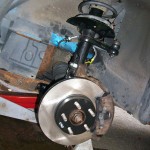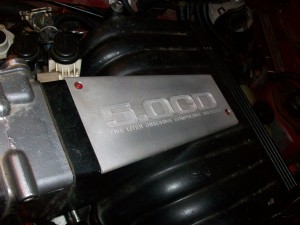That’s for Brakes and Suspension. Ok, and maybe something else too for all the other troubles.
The two door Sunbird has been off the road for a few weeks now since I decided to tackle everything brake and suspension related all at once in an effort to head off any potential problems before winter hits. Also I knew some of these things needed attention, but there’s always more than you think. In the past I’ve done some major repairs outside, laying on the ground in well below freezing temperatures, but I would rather avoid that if I can.
To start things off, here is what’s being done. Out front it’s getting new struts, mounts, tie rod ends, ball joints, control arm bushings, braided lines, ABS deleted, rotors, pads, and new transmission to radiator cooler lines. In the rear it’s getting braided flex lines, wheel cylinders and some new hard lines. Not one to leave things alone, I ditched the non-functioning ABS to shed a few pounds and clean up the engine bay, upgraded to some Centric cryo-treated rotors, added Goodridge braided brake lines, put in some Hawk HPS pads, and did some Energy Suspension poly bushings in the control arms. I am pretty interested to see what all these items amount to in stopping power. More on that when it’s all done.
Next up, here are some things that might be useful for anyone else about to take on any of these tasks.
1. If you’re interested in what’s involved in deleting the ABS, read this.
2. If you are considering some Goodridge lines for your J body, there is one important thing to note – the rear lines are not bubble flare. At least the ones that came in my kit weren’t. This means you will not be able to directly bolt these lines up to your factory brake lines in the back. You will need to reflare the lines.
3. If you ordered some parts from Rockauto like I did and wanted to replace your strut bolts, they are not listed for this car, but guess what – they carry them! Part number AK42.
4. If you are replacing the rear wheel/brake cylinders, you’ll find that it is kind of a puzzle to slide them out between the hub and backing plate. It can be done. You also may find the new ones impossible to fit in the same way. This can be rectified by grinding away some material between the two mounting holes (I just made a big radius using a cutoff wheel) and then the cylinder can be slid in and rotated into position with nothing in the way. If that’s not clear enough, leave a comment asking for an illustration and I can put one up.
What project is complete without all of the inevitable snags? On to some of the other problems I’ve had along the way not including the ones listed above. Most of the front suspension and brake work went without any problems. This only serves to lull one into a false sense of security that the job will go smoothly the rest of the way. Don’t be fooled. Moving to the back, I pulled the drums off to check out the pads. They were in ok shape so I figured I would leave them alone. Then, however, both of the bleeders sheared off in the cylinders. After trying to EZout (I’ve never had this work on anything) and drill, I realized it was a waste of time and it would be easier to replace them… or would it? All of the brake equipment now had to come off also, good shape or not. Only one out of four of the not-so-convenient external-torx-head bolts came out, while the other four stripped. Wonderful. So the other three all had to have the heads ground off to free the cylinders, which are a bit of a tight fit to remove anyway as mentioned above. Of course, the fun didn’t end there. Almost all of the brake line fittings had seen a few too many winters, and so many sheared off, broke the line with them, or had to be removed by vise grips. Which means new lines and fittings had to be purchased, flared, coupled, bent into position, and so on.
Anyhow, there is light at the end of the tunnel and the whole project is nearly complete. As of this writing, I still have the passenger side rear replacement brake lines to do, the trans lines, reassembling the rear brakes, filling and bleeding the brakes, an oil change, and an alignment to call it done.

fancy stuff: cryo stops, hawk hps, stainless flex lines

brakes & suspension in progress

















